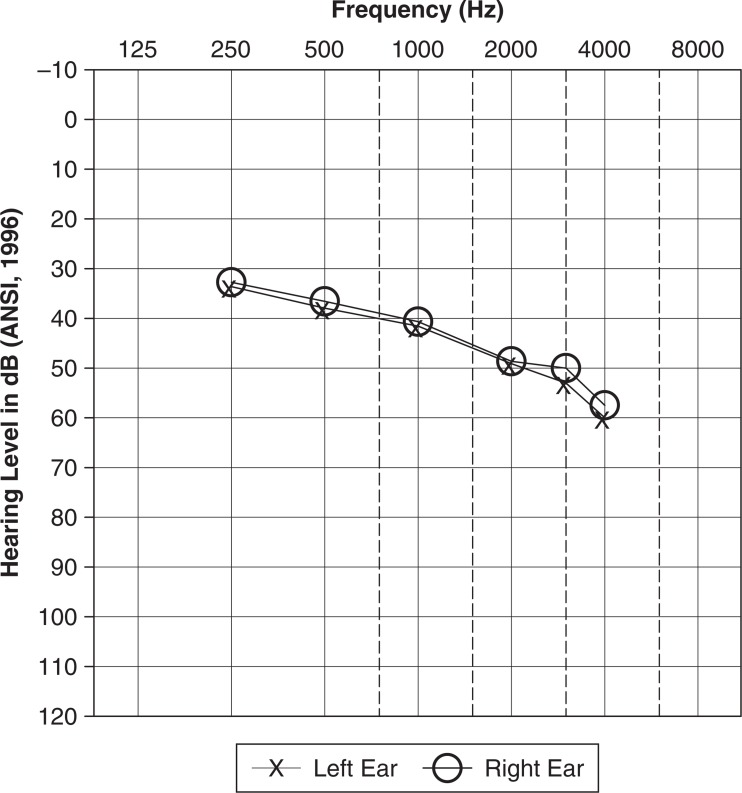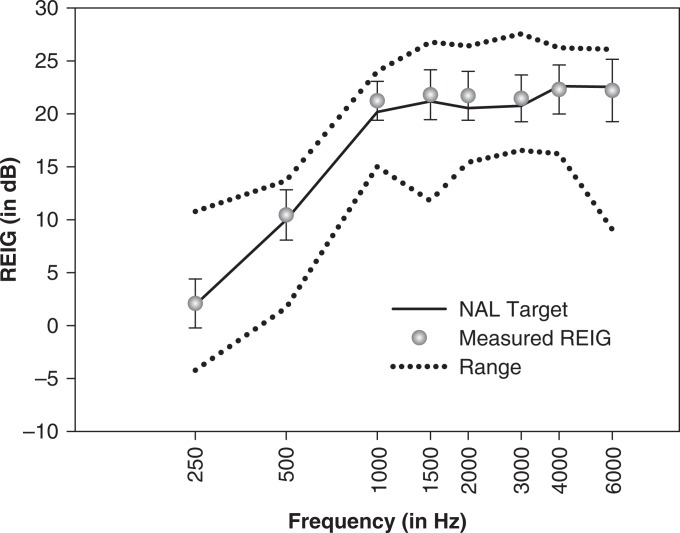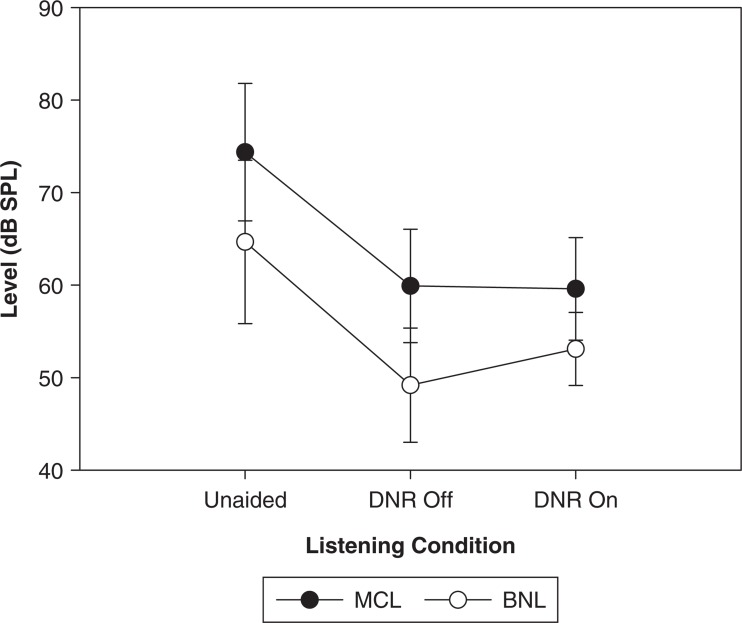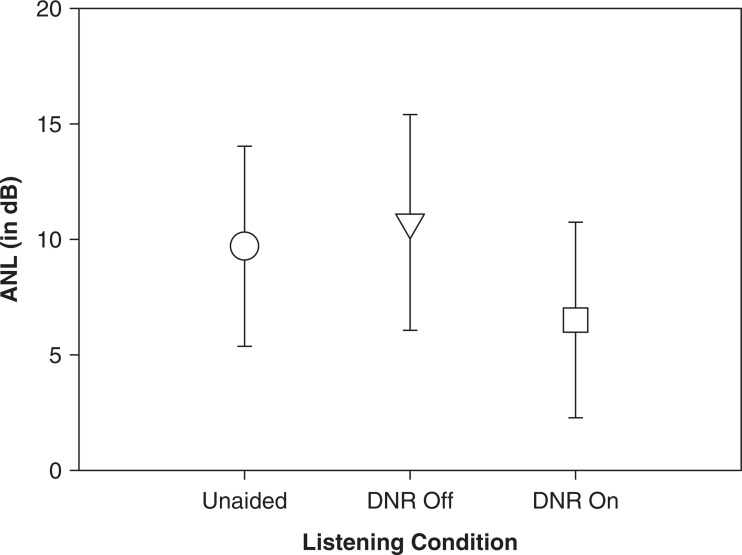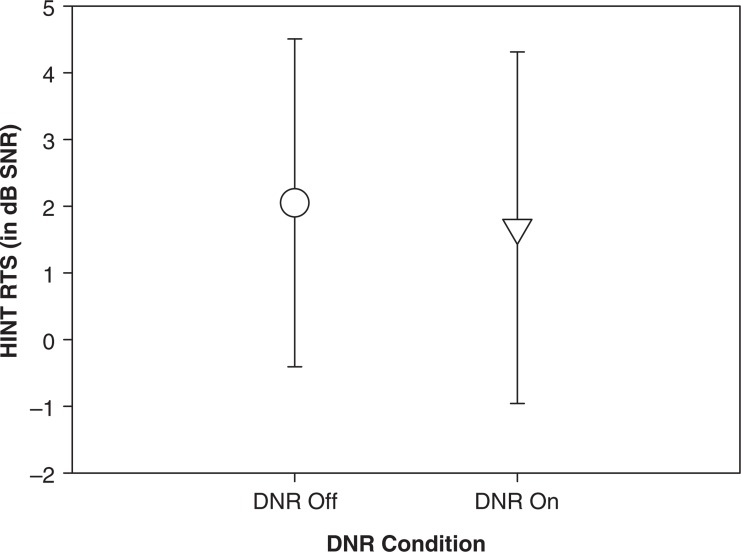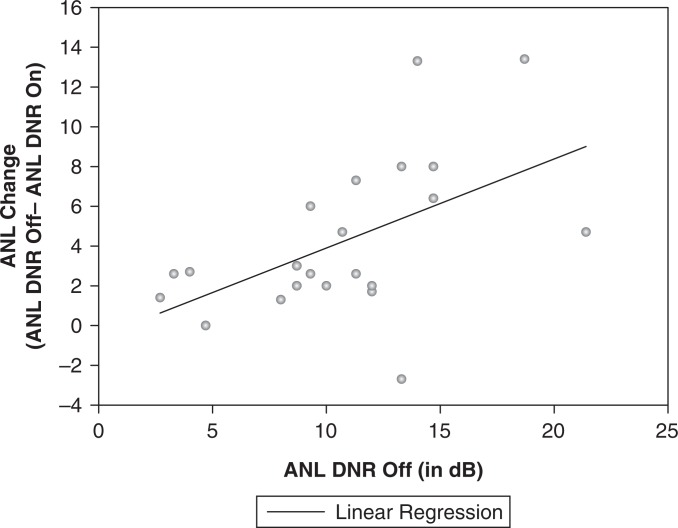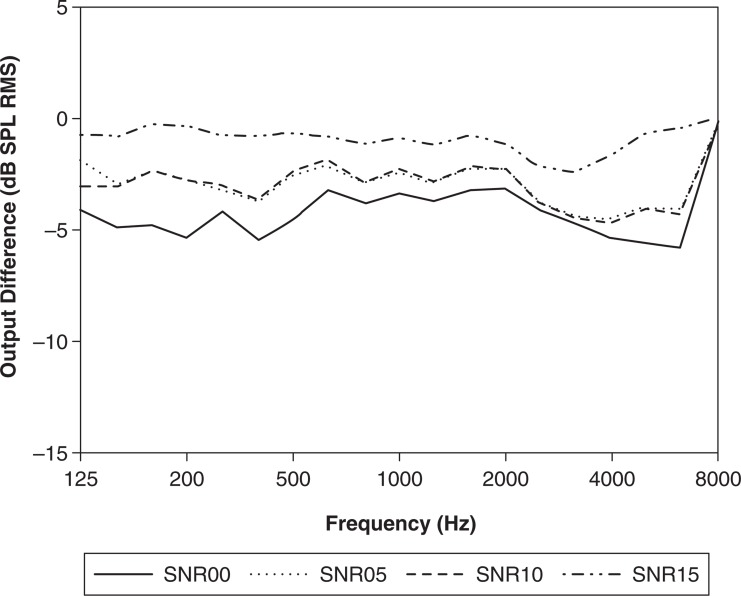Abstract
Modern hearing aids commonly employ digital noise reduction (DNR) algorithms. The potential benefit of these algorithms is to provide improved speech understanding in noise or, at the least, to provide relaxed listening or increased ease of listening. In this study, 22 adults were fitted with 16-channel wide-dynamic-range compression hearing aids containing DNR processing. The DNR includes both modulation-based and Wiener-filter-type algorithms working simultaneously. Both speech intelligibility and acceptable noise level (ANL) were assessed using the Hearing in Noise Test (HINT) with DNR on and DNR off. The ANL was also assessed without hearing aids. The results showed a significant mean improvement for the ANL (4.2 dB) for the DNR-on condition when compared to DNR-off condition. Moreover, there was a significant correlation between the magnitude of ANL improvement (relative to DNR on) and the DNR-off ANL. There was no significant mean improvement for the HINT for the DNR-on condition, and on an individual basis, the HINT score did not significantly correlate with either aided ANL (DNR on or DNR off). These findings suggest that at least within the constraints of the DNR algorithms and test conditions employed in this study, DNR can significantly improve the clinically measured ANL, which may result in improved ease of listening for speech-in-noise situations.
Keywords: hearing aids, digital noise reduction (DNR), background noise, acceptable noise level (ANL)
It has been nearly 10 years since digital noise reduction (DNR) was introduced as a feature of wearable hearing aids. Today, DNR is considered a standard fitting option by many audiologists, and the majority of hearing aids manufactured include a DNR algorithm.1 The general goal of most DNR algorithms, as implemented in hearing aids, is to reduce hearing aid gain for background noise while limiting any effects on speech signals. The motivation for this processing is to improve ease of listening, listening comfort, sound quality, and potentially, speech understanding in noise.2,3
The primary goal in the design of DNR algorithms is to improve speech intelligibility in background noise. This attempt often focuses on reducing overall gain in frequency regions where noise is the dominant signal, using a modulation-based algorithm. Other DNR algorithms use fast-acting filtering, attempting to reduce interword and intersyllablic noise.2,4 In theory, if the characteristics of the speech and noise are known (which is quite difficult outside the laboratory), DNR algorithms certainly have the potential to improve speech understanding.5
A secondary goal of DNR is to provide relaxed listening or to improve ease of listening. That is, the reduction of background noise, even when speech is not present, may reduce listening fatigue and increase listening awareness. In addition, in difficult listening situations, an improvement in central auditory space allocation could result, which could assist in cognitive processing. A potential benefit of DNR use therefore would be a more alert and focused listener.
Although there has been much written regarding the potential benefits of DNR for both speech intelligibility and listening comfort, there is little published data to support these claims. Bentler3 recently conducted a systematic review of this topic. In her review, she concludes that there are only “equivocal” findings regarding the subjective benefit of DNR in the real world. Even if we include laboratory data, there is little evidence supporting improved speech understanding or listening comfort.6–8 One exception is the recent work of Ricketts and Hornsby,9 who studied hearing aids that used both modulation-based and fast-acting Wiener filter DNR algorithms working simultaneously. They report that their participants showed a significant preference for DNR on versus DNR off for paired-comparison testing while listening to speech in noise. The preference was present for both omnidirectional and directional technology. Of interest, these participants did not demonstrate an intelligibility improvement in the same noise for DNR on, suggesting that the preference was based on perceptual factors other than speech understanding.
As discussed, a potential benefit of DNR is to make background noise less annoying. This could improve ease of listening, which could improve subjective hearing aid benefit and satisfaction. Other than the aversiveness scale of the Abbreviated Profile of Hearing Aid Benefit (APHAB),10 individual noise annoyance is not a common clinical or research laboratory measure. One clinical procedure, however, which addresses this perception, is the acceptable noise level (ANL), which was described by Nabelek et al.11 According to Nabelek and colleagues,11 the ANL is defined as the difference between the patient's most comfortable level (MCL) for speech and the highest level of background noise that the patient reports as acceptable, referred to as the background noise level (BNL). The BNL judgment is made with the noise presented simultaneously with speech at the speech-in-quiet MCL. Hence, the speech MCL minus the BNL equals the ANL. The ANL is not a level per se but rather a signal-to-noise ratio that is acceptable to the listener (eg, a signal-to-noise ratio that they could “put up with” if required to listen to in such a situation). That is, a given patient with low acceptance of background noise would have a large ANL, and a patient with high acceptance of background noise would have a low ANL. Most of the published research concerning the ANL has been from the University of Tennessee laboratories, and this work recently was reviewed by Nabelek.12 In general, their research has shown that the ANL is not related to degree of hearing loss, age, gender, the type of background noise, or whether the ANL test (ANLT) is conducted unaided or aided.12–15 Moreover, Nabelek et al14 found that on an individual basis, the ANL was not correlated with the subject's speech perception in background noise for either unaided or aided conditions.
Although not related to speech understanding in noise, limited research has shown that the ANL is a useful predictor of hearing aid use,12 which often is related to hearing aid satisfaction. For example, the data of Nabelek et al16 suggest that full-time hearing aid users have significantly lower ANLs than do part-time users and nonusers. They report that by using the ANL value, success with hearing aids can be predicted quite effectively (eg, the accuracy of the prediction was 87.0% for the successful users and 83.6% for the unsuccessful users). In summarizing the University of Tennessee research, Nabelek12 reports that in general, the chances of successful hearing aid use increase as ANLs decrease. Furthermore, an ANL of about 10 dB (or lower) has been shown to relate to successful hearing aid use.
There has been little use of the ANL as a means to assess the effectiveness of different hearing aid processing. Freyaldenhoven et al13 used the ANL calculation to measure the effectiveness of hearing aids with directional technology by presenting the noise signal from 180° azimuth, whereas the speech signal was presented at 0° azimuth. They found that the ANL was significantly correlated to the masked speech recognition threshold and concluded that the ANLT could be used to measure the effectiveness of hearing aids with directional technology.
Given that the ANLT is geared to measure the annoyance or some aspect of annoyance of background noise and that DNR algorithms are designed to reduce the annoyance of background noise, the ANLT would appear to be a useful tool in the laboratory, and maybe even the clinic, to assess the effectiveness of DNR technology. The present study was designed to determine if activation of DNR processing would improve the aided ANL. In addition, we sought to determine if there were specific patient variables that could be used to predict individual ANLs or ANL change, if any, when DNR was activated. Specifically, we were interested in variables such as degree of hearing loss, hearing aid gain, speech intelligibility in noise, and unaided and aided MCLs.
Procedures
Participants
The participants in this study were 22 adults, 14 men and 8 women. Their ages ranged from 23 to 76 years; mean age was 58.8 years. The participants had mild-moderate sensorineural hearing loss, predominantly downward sloping (Figure 1). Losses were essentially symmetrical (∼93% of thresholds were ±15 dB) and all participants, according to their report, were experienced, full-time users of bilateral hearing aids.
Figure 1.
Mean audiogram of the 22 participants in the study.
Hearing Aids
The hearing aids used in this research were behind-the-ear Siemens ACURIS Model S (Siemens Hearing Instruments Inc, Piscataway, NJ), employing 16-channel input compression (AGCi), low-level expansion, and output compression (AGCo). The hearing aids had directional technology, which was disabled, and adaptive feedback cancellation, which was enabled during experimental testing. The hearing aids also had a feature allowing for continuous electromagnetic transmission between the instruments, which links the sound classification system controlling the activation and strength of the DNR. This feature was active, which resulted in the same DNR processing (on vs off) for both hearing aids during testing.
The hearing instruments employed 2 different types of DNR algorithms, which operate simultaneously and independently in 16 channels. One DNR algorithm is modulation based, an advanced version of the algorithm described by Powers et al.17 It is designed to reduce channel-specific gain when the dominant signal in that channel is relatively steady state and has been classified as noise. The onset time for this algorithm to reach maximum gain reduction is gradual (∼5–7 seconds) and the offset time is ∼500 milliseconds. The strength of the gain reduction is independent of overall input level and can be programmed in the fitting software.
The second DNR algorithm is an adaptive fast-acting noise reduction system, similar in design to Wiener filter technology.18 The time constant of the filter is 10 milliseconds. Within this adaptive time constant, the filter tracks the signal envelope independently in each channel and calculates the signal-to-noise ratio and the filter coefficient, which is then directly applied to the signal within that channel. As implemented in this instrument, this DNR algorithm operates continuously (unless all adaptive parameters are disabled), regardless of the presence of modulations in the input signal.
All participants were fitted bilaterally. If the participants did not have their own custom ear molds, foam Comply tips (Hearing Components, Inc, Oakdale, Minn) were used. The hearing aids were initially programmed using the Siemens CONNEXX 5.0 version of the National Acoustics Laboratory–nonlinear version 1 (NAL-NL1) fitting algorithm (Siemens Hearing Instruments Inc).19 The AGCo kneepoints were programmed based on the subject's frequency-specific loudness discomfort levels. Expansion kneepoints were not programmable and were approximately 45 to 48 dB sound pressure level (SPL) in the lower channels and 35 to 38 dB SPL in the higher channels. Probe-microphone measurements (Audioscan RM500; Audioscan, Dorchester, Canada) and real ear insertion gain (REIG) calculations were conducted to verify the fit to REIG target, and adjustments to gain and compression were made until an acceptable fit was obtained. Given the essentially symmetrical hearing losses of our participants, for display purposes, REIG calculations were averaged across ears and are shown in Figure 2 (for a 65-dB SPL input). As shown by the error bars on Figure 2, on an individual basis, there was a close match to REIG target throughout the fitting range. The mean root mean square (rms) fitting error for the 44 ears (right and left for 22 participants) across the 8 key frequencies was 2.4 dB, with an rms error range of 2.1 dB (1000 Hz) to 2.7 dB (4000 Hz).
Figure 2.
Mean National Acoustics Laboratory–nonlinear version 1 (NAL-NL1) target (solid line) and real ear insertion gains (REIGs; filled circles) for 44 ears (22 participants) for a 65-dB sound pressure level input. Error bars represent 1 standard deviation from target. Maximum deviation from targets as a function of frequency is shown by the dotted lines.
Once all parameters had been optimally programmed in program 1, these settings were copied to program 2, and the DNR algorithms were activated in program 2. The strength of DNR was programmed to “maximum.” This setting would be expected to provide an 8- to 10-dB reduction for stationary noise if AGCi compression ratios ∼2:1 are used. Other than DNR activation, the settings for program 2 were identical to program 1.
Speech Material
The speech material used for both the ANLT and intelligibility-in-noise measures was the speech and noise recording from the Hearing in Noise Test (HINT).20 The HINT is an adaptive procedure that requires the listener to repeat recorded sentences of a male talker in the presence of speech-shaped noise. The noise level remains fixed, and the level of the sentence is adaptively adjusted based on the subject's performance on the preceding sentence. All the key words of a sentence must be accurately repeated for the sentence to be considered correct. The HINT score reflects the signal-to-noise ratio in which the subject scores 50% correct and is referred to as the reception threshold for sentences.
For the present investigation, the HINT material was modified so that the standard background masker (steady-state noise filtered to match the long-term average spectrum of the sentences) was on continuously. This was to ensure that the onset time of the modulation-based DNR algorithm, which is several seconds, would not be a confounding variable. In other words, having the noise on continuously between sentences ensured that along with the Wiener filter, the modulation-based DNR algorithm was active before each HINT sentence presentation.
For the ANLT, the HINT material was presented according to ANLT protocol; that is, the sentences were presented adaptively to obtain the MCL, and the noise was presented adaptively to obtain the BNL, whereas the sentences were at a constant level at the participant's MCL. For the HINT, the noise was presented at a constant 65-dB SPL, and the level of the sentences was varied adaptively.
We chose to use the speech and noise material from the HINT for the ANLT so that the same speech and noise material would then be used for speech-in-noise intelligibility and the ANLT, allowing for a direct comparison of findings. In addition, the gaps between sentences for the speech provided a listening situation that probably is more typical of real-world listening than is the continuous discourse typically used for the ANLT. Although most previous ANL research has used multitalker babble as the background noise (eg, the background noise of the revised Speech Perception in Noise Test), the type of background noise does not appear to affect the size of the calculated ANL.12
Procedures
Testing for the speech intelligibility and the ANL were conducted in an audiometric test suite (Tracoustics RS-254; Acoustic Systems, Austin, Tex). The subject was seated 1 m from the loudspeaker (Tannoy i5 AW point source, Tannoy Limited Corp, Coatbridge, Scotland) located at a 0° azimuth. For both tests, speech and noise were presented from the same loudspeaker. The HINT material was delivered from a Sony compact disc player (CE105; Sony Corp, New York, NY) routed through a standard clinical audiometer (Grason Stadler Model 61; Viasys Healthcare Inc, Madison, Wis).
All participants first received the HINT. Standard instructions were read to the patient, and two 10-item lists were used for establishing the reception threshold for sentences for each subject. Testing was conducted for 2 conditions: aided–DNR off and aided–DNR on. The 2 conditions were counterbalanced, and the participants were randomly assigned.
Following the HINT, the participants were administered the ANLT. The instructions for the ANLT were modeled after those used in previous ANL research.13,21 The following instructions, presented verbally, were used for determining the MCL:
You will be listening to several sentences presented from the loudspeaker in front of you. Our goal is to determine your most comfortable listening level. After each sentence, you will be asked to adjust the loudness. Please signal with your thumb pointing up if you prefer the speech louder and with your thumb pointing down if you prefer the speech softer. First, signal for the sentences to be turned up to a level that is too loud and then down to a level that is too soft, and then select your comfortable listening level. When the sentences are at a comfortable level, please signal with a flat hand.
The first sentence was presented at 40 dB SPL, and the level was increased in 5-dB steps for subsequent sentences corresponding to the subject's hand signal. When it was confirmed (verbally) that the signal had exceeded the subject's MCL, the signal was then reduced in 2-dB steps, and 2-dB steps were used for the duration of testing.
After the measurement of MCL, the second portion of the ANLT was to obtain the BNL. Instructions for this procedure were as follows13:
You will now be listening to the sentences with a background noise present. After you listen to each sentence, select the level of the background noise that you would be willing to accept or “put up with” without becoming tense or tired while listening to the sentences. First, signal to have the noise turned up until it is too loud, and then signal to have it turned down until it becomes too soft. Finally, signal to have the noise turned either up or down until you find the maximum level that you would “put up with” for a long time while listening to the sentences. When the noise is at your maximum acceptable level, signal with a flat hand.
For BNL testing, the background noise was presented continuously while the HINT sentences were delivered at the subject's MCL. The background noise was introduced at 40 dB SPL and then raised in 5-dB steps until an unacceptably high level was reached. For the remainder of BNL testing, 2-dB steps were employed. Verbal confirmation was obtained for too loud, too soft, and final ratings. The BNL procedure was repeated 3 times for each subject (within the same test session), and the mean BNL value was used for data analysis and to calculate the ANL.
The ANLT was conducted for 3 conditions: unaided, aided with DNR off, and aided with DNR on. The test ordering was counterbalanced, and participants were randomly assigned a given test order. Although it might be assumed that the aided MCL would be the same for both DNR conditions, this measure was repeated, as there have been some reports that DNR algorithms can reduce gain for speech in quiet.4
During testing for both the HINT and the ANLT, the audible beeps from the hearing aids (eg, 1 beep for program 1; 2 beeps for program 2) were used to ensure that the hearing aids were set to the correct program for a given test presentation. The participants were blinded to the technology under investigation.
Results
The focus of this research was on the effects of DNR on the acceptance of background noise, as measured by the ANLT. As a reference, we also measured the ANL in the unaided condition, and therefore, there were 3 ANLTs administered to each subject. To calculate the ANL, it is necessary to measure the MCL for speech in quiet and the BNL, measured in the presence of speech at the participant's MCL. The mean results for these 2 measures for the 3 experimental conditions are shown in Figure 3. As expected, the mean soundfield presentation levels for both the MCL and BNL were reduced in the aided conditions.
Figure 3.
Mean most comfortable levels (MCLs; filled circles) for speech in quiet and mean acceptable background noise levels (BNLs; open circles) for steady-state noise presented with speech at quiet MCL as a function of experimental condition (unaided, aided–DNR on, and aided–DNR off). Error bars represent 1 standard deviation around mean values.
A primary interest of this study was to determine if the ANL (the difference between the MCL and the BNL) was affected by the use of DNR in hearing aids. The calculated ANLs as a function of listening condition are shown in Figure 4.
Figure 4.
Acceptable noise levels (ANLs, in dB) as a function of test condition (ANL = MCL – BNL). Error bars represent 1 standard deviation around mean values.
An initial, single-factor analysis of variance (ANOVA) was performed to examine differences in ANLs across our test conditions. The within-subjects independent variable was listening condition (unaided, aided–DNR on, and aided–DNR off) and the dependent variable was the ANL in each listening condition. The initial ANOVA showed a significant main effect of listening condition (F2,42 = 17.23, P < .001). To explore this significant main effect, follow-up testing, using a series of single-factor repeated-measures ANOVAs, was performed. Results of this testing showed that there was no significant difference between the unaided and DNR-off conditions (F1,21 = 2.14, P = .158). In contrast, ANLs obtained in the DNR-on condition were significantly smaller than either the unaided (F1,21 = 21.09, P < .001) or DNR-off conditions (F1,21 = 25.16, P < .001).
The results of the above analyses suggested that the DNR algorithm used in this study significantly improved acceptance of background noise for our participants. Although previous research has suggested that speech understanding is not likely to improve with the use of DNR algorithms, it also was of interest to verify that the algorithm did not negatively affect speech understanding.
Figure 5 shows the mean HINT results for the 2 aided conditions (the HINT was not conducted in the unaided condition). A single-factor, repeated-measures ANOVA was used to examine differences in HINT scores as a function of DNR condition. The within-subjects independent variable was DNR condition (on or off), and the dependent variable was the HINT score. Results showed that the implementation of the DNR algorithm had no effect (positive or negative) on HINT scores (F1,21 = 1.00, P = .328).
Figure 5.
Hearing-in-Noise Test (HINT) thresholds (in dB signal-to-noise ratio) as a function of digital noise reduction (DNR) condition. Error bars show 1 standard deviation around the mean. RTS = reception threshold for sentences.
A secondary purpose of this study was to identify factors related to ANLs. A series of correlation analyses, using the Bonferroni procedure to control for increases in type I error rate with multiple comparisons, were used to examine potential relationships between factors of interest and ANLs. Potential factors of interest included speech understanding in noise abilities (HINT thresholds) and frequency-specific measures of auditory threshold and hearing aid gain (REIG).
As previously shown, 2 speech-in-noise measures were obtained for each subject (ANL and HINT). Results of the correlation analyses between speech understanding abilities and ANLs, however, showed they were not significantly correlated. Specifically, HINT thresholds (DNR off and DNR on) were not significantly correlated to ANLs measured with or without the DNR activated (P > .05).
We questioned whether ANLs or the change in ANL with DNR use might be related to degree of hearing loss, which indirectly is related to programmed REIG. Correlation analyses, however, showed no significant relationships between either auditory threshold or programmed REIG (250–4000 Hz) and the participants’ ANLs.
In reviewing the raw data, we observed that those who had a larger ANL for the aided DNR-off condition tended to show the most improvement for the DNR-on condition. Further study of this observation revealed a significant (r = .529, P [2-tailed] = .011) correlation between ANLs measured with DNR off (baseline aided ANL) and DNR benefit. Figure 6 shows the relationship between the baseline ANL (DNR off) and the improvement in ANL with DNR activated.
Figure 6.
Baseline acceptable noise level (ANL) with digital noise reduction (DNR) off as a function of change in ANL with DNR on. Solid line shows linear regression of the data.
The intercept of the linear regression of the data is ∼0 dB, suggesting that DNR probably will not affect ANLs much for people with ANLs of ∼0 dB. The slope of the regression function is ∼0.45 dB/dB, suggesting that as ANL increases above 0 dB, the DNR system will provide ∼45% reduction in their ANL (although as seen in Figure 6, variability can be quite large, particularly for larger ANLs). It also implies that persons with DNR-off ANLs greater than ∼20 dB may need more than DNR to find hearing aids acceptable in background noise, as a 45% reduction would probably still result in ANLs greater than 10 dB.
Discussion
The findings presented here are some of the first published ANL data from research conducted outside of the University of Tennessee's auditory research laboratory. In general, our results were quite similar to those previously reported findings. For example, Nabelek12 reports an ANL range of −2 to 29 dB, with a mean of 10 to 11 dB obtained from 315 hearing-impaired listeners. The range for unaided ANLs for our participants was 2 to 17 dB, with a mean ANL of 9.7 dB. Also consistent with the University of Tennessee laboratory findings, we found no difference between the unaided and aided ANLs (9.7 dB vs 10.7 dB) and found no significant correlation between the size of the ANL and the degree of hearing loss.
The primary purpose of this research was to determine if a commercially implemented DNR algorithm improved the ANL. At least one previous study,9 using hearing aids with similar DNR algorithms, has shown that the majority of listeners prefer DNR on to DNR off for listening to speech in noise. It was not clear, however, why their participants had this preference, as there was no improvement in speech understanding in the same noise for the DNR-on condition. Our data show that at least for the speech-in-noise task used in this study and the DNR algorithms used in this study, DNR provides a significant improvement in the ANL. The mean improvement observed (4.2 dB) was essentially the same as reported by Freyaldenhoven et al13 for directional technology when the background noise was presented from 180° azimuth. Only 2 of our 22 participants failed to show an improvement in ANL when the DNR algorithm was activated. It is important that the mean MCL did not change for the DNR-off versus the DNR-on conditions (see Figure 3), a factor which could have influenced the resulting ANL. Although this finding was expected, it is possible that a DNR algorithm can reduce gain for speech in quiet.4
As shown in Figure 6, no subject with an aided ANL of 8 dB or fewer for the DNR-off condition showed an improvement of more than 3.5 dB with DNR on. This finding suggests there may be an ANL ceiling effect when the BNL reaches a level at which the background noise is reducing intelligibility. That is, at some point, the listener's percept may shift from “what level can I put up with” to “what level is reducing speech understanding.” For example, some of our participants who had DNR-off ANLs of 5 dB or fewer had HINT reception threshold for sentences scores for DNR-on of 2 to 3 dB. For these individuals to show a significant improvement in ANL for the DNR-on condition, they would have had to select an acceptance level of background noise that resulted in a signal-to-noise ratio more adverse than their HINT reception threshold for sentences.
As mentioned earlier, Nabelek12 has suggested that an aided ANL of around 10 dB or better is predictive of successful hearing aid use. We were interested to observe how this criterion compared with our aided findings. To do this, we plotted individual ANL data for the 22 participants for both the DNR-off and DNR-on conditions. These data are displayed in Figure 7. Observe that for DNR off, only 45.4% (10 of 22) of the participants met the 10-dB criterion, whereas with DNR on, 86.3% (19 of 22) of the participants had an aided ANL of 10 dB or better. It is important to note, however, that further research is needed to determine if ANLs measured with DNR activated are related to hearing aid use and/or satisfaction.
Figure 7.
Acceptable noise levels (ANLs, in dB), obtained in digital noise reduction (DNR)–off and DNR-on conditions, for each participant. Acceptable noise level data are sorted based on magnitude of ANL in DNR-off condition.
Given the consistency of improvement for the DNR-on condition across participants and the large changes observed in ANL for some participants, it is relevant to discuss the signal processing that caused this positive finding. It clearly was related to the DNR algorithms, as this was the only signal-processing difference between program 1 and program 2. Recall that the hearing aids used in this study had 2 different DNR algorithms, which operate independently in 16 channels, and could operate simultaneously, depending on the input signal. Recall also that the background noise was steady state and relatively stationary, the noise was on continuously, there were gaps between the sentences, and most ANL testing was conducted at signal-to-noise ratios of +5 dB or higher.
With this in mind, it seems most probable that the Wiener filter DNR algorithm reduced interword, intersyllable, and intersentence noise, lowering the overall percept of the loudness of the noise during the BNL measure. We know that the Wiener filter is fast acting (an adaptive 10-millisecond time constant), and unlike modulation-based DNR, it can be efficient when the signal-to-noise ratio is positive. Also, it is most efficient when the background noise is relatively stationary, as it was during the BNL measurements (altered in 2-dB steps). This DNR processing certainly could explain the magnitude and consistency of improvement shown for our subjects.
There are several reasons why it seems unlikely that the modulation-based DNR contributed to the reduced ANLs. First, although this algorithm will reduce channel-specific gain when noise is the dominant signal, consider that the HINT masker is a steady-state noise that has been especially filtered to match the long-term average spectrum of the HINT sentences. Although there could be slight speech or noise differences at some frequencies, they would not be expected to cause loudness judgments to be altered to the extent that we observed in the ANL. In addition, if there were an overall gain reduction, we would expect this to occur in the low frequencies—our subjects had very little gain in the low frequencies (see Figure 2), and low-frequency REIG was not correlated to ANL improvement.
A second reason why we doubt that the modulation-based DNR contributed significantly is that most of the DNR-on ANLs were at signal-to-noise ratios of +5 dB or higher (see Figure 7), a signal-to-noise ratio at which we would expect little reduction of gain from the modulation-based DNR algorithm used in this study. Recall also that there was no difference for aided MCLs for DNR on versus DNR off, confirming that the modulation-based DNR did not affect speech in quiet (see Figure 3). Also, if the modulation-based DNR were responsible, we would expect to notice the greatest effects for the persons with small ANLs, as this was when the noise was only a few decibels different from the speech signal. At these poor signal-to-noise ratios, it is possible that the overall signal would be classified as noise. The opposite was true, however, as the largest DNR improvement was for the people who had the largest ANLs (see Figure 6).
Finally, although we know that both the modulation-based DNR and the Wiener filter reduced the output of the noise during the gaps between sentences, perhaps by as much as 10 dB or more for some frequency regions (depending on the programmed gain and the AGCi settings), the offset of the modulation-based DNR is relatively short (∼500 milliseconds). The reduction of gain between sentences offered by the modulation-based DNR, therefore, would seem to have little if any effect on the participant's noise acceptance when the sentence was presented at a positive signal-to-noise ratio. Moreover, this would have reduced gain for both speech and noise and, therefore, had little influence on the noise-acceptance measure.
Much of this speculation, of course, could be resolved by electroacoustic measures for the different DNR algorithms using the HINT material as the input. Unfortunately, the 2 different algorithms cannot be uncoupled, so it is not possible to observe the contributions of each for different inputs. What we did measure, however, was the effects of the combined algorithms for the HINT sentences combined with the HINT noise for 4 different signal-to-noise ratios. This is shown in Figure 8. Because most ANL testing was conducted at signal-to-noise ratios greater than 5 dB, these findings support our earlier comments that for most of the ANL measures, there was little reduction in gain when the speech and noise signal was combined.
Figure 8.
Mean 30-second root mean square (rms) values showing the degree of gain reduction for the Hearing-in-Noise Test (HINT) material (65-dB sound pressure level input) presented with the HINT noise for 4 different signal-to-noise ratios. Noise reduction was set to maximum, and the hearing aids were programmed using the National Acoustics Laboratory–nonlinear version 1 (NAL-NL1) algorithm for the mean hearing loss of the study participants. The 0-dB reference is DNR off. SNR = signal-to-noise ratio.
A secondary component of our research was to examine the relationship between a person's ANL and his or her speech understanding in noise. Prior research has suggested that an individual person's ANL is not related to his or her speech-in-noise intelligibility score.14,21 In this research, we purposely selected the HINT so that we could use the same material for both ANLT and intelligibility measures and so that we would have both tests scored in a signal-to-noise format. As with previous research, however, there was no significant correlation between tests. Although some of our participants showed ANL improvements of 10 dB or more when DNR was activated, it is not surprising that the DNR did not improve speech intelligibility. Although we assume that the DNR algorithm reduced the noise in the gaps between the words and syllables of the sentence, creating a percept of less noise (thus raising the BNL), the signal-to-noise ratio of the remaining speech and noise did not change. It is important to point out that while using an algorithm that improved ANLs, speech intelligibility did not become worse. As reviewed by Harkrider and Smith,21 the ANL measure probably involves different auditory centers and physiologic processing than a speech intelligibility-in-noise task.
We questioned whether there might be audiometric or hearing aid factors that contributed to the change in the ANL for the DNR-on condition. For example, some participants had little or no hearing loss in the low frequencies, meaning that these persons received little or no hearing aid gain for this frequency region. If there is little gain in a given frequency region, then the effects of DNR obviously are reduced. Our analysis showed, however, that neither hearing thresholds nor programmed REIG was correlated with the ANL. Our participants were, however, relatively audiometrically homogenous, which could have influenced this finding.
From a clinical standpoint, it is relevant to comment on the use of the HINT for the ANLT. One of the reasons we selected the HINT was because we wanted to have the same material for the ANLT as was used for the speech intelligibility measure, and the HINT is recognized as a highly reliable and sensitive speech-in-noise test.20 We would not recommend the HINT, however, in its standard format as a clinical speech-in-noise material for the ANLT because of the pauses between sentences. Although the pauses might create a more real-world listening situation, nearly all of our participants made the MCL and BNL perceptual judgments very quickly, and the pauses between sentences unnecessarily extended the overall test procedure.
A second procedural issue concerns the number of runs used to establish the BNL. We used 3 BNL measures for each condition and then obtained a mean for ANL calculation. Our reason for using 3 was because we believed that the BNL task might be somewhat confusing for the participants. The perceptual task of “the highest level that you can put up with” did not seem as straightforward as the threshold or loudness discomfort level measurements that the participants were familiar with. The reliability of the BNL judgments, however, was surprisingly good. Consider that each of the 22 participants had 3 ANLTs (unaided, aided–DNR off, and aided–DNR on); 66 ANLTs, therefore, were conducted, and 3 BNL measures were obtained for each ANLT. When we compared the 3 BNL values for the 66 ANLTs, in 15.1% of the tests, the BNL values did not differ at all, and in 60.7% of the tests the largest difference among the 3 measures was 2 dB (2-dB steps were used). In 13.6% of the tests, the BNLs differed by 4 dB. The biggest difference among the 3 BNLs was 6 dB, which occurred in 10.6% of the 66 ANLTs. For clinical purposes, it would seem that 1 or 2 BNL measures would be adequate unless it was apparent that the patient was having trouble understanding the task.
It is important to comment on the real-world generalization of these findings. Although a significant correlation has been shown between the clinically measured ANL and real-world outcome measures of hearing aid use,16 it is not clear that an improvement in ANL due to hearing aid processing would result in a similar improvement in hearing aid use or satisfaction. In addition, the Nabelek et al16 data were collected using a different speech and noise signal than used in the present study. Although Nabelek12 reports that the type of background noise does not affect the measured ANL, this might not be true for aided testing when the effectiveness of DNR is assessed. Further study is needed with different types of background noise signals to determine whether the same ANL improvement for DNR is present. If the ANL improvement shown here with DNR on was related to the gaps between sentences (when only the speech-shaped noise was present), then we would not expect the effect to be as great if the background noise between sentences were more speechlike. In addition, the present testing was conducted in a relatively reverberation-free audiometric test suite. It is certainly possible that reverberation could affect ANL measures; testing with different types of background noises in different levels of reverberation would help determine the real-world generalization of our findings. Finally, further study is needed with different hearing aid models to determine if the ANL improvement noted here is also present with other types of DNR algorithms.
Acknowledgments
The authors thank Sara Gill and Theresa Scarlotta, both AuD students at the University of Northern Colorado, for their assistance with data collection. They also want to thank Hua Oliver Ou of the University of Iowa for her assistance with data analysis. This research was funded in part by Siemens Hearing Instruments Inc. H. Gustav Mueller is a consultant for Siemens Hearing Instruments Inc.
References
- 1.Kirkwood DH. Dispensers surveyed on what leads to patient satisfaction. Hear J. 2005;58: 19–29 [Google Scholar]
- 2.Mueller HG, Ricketts TA. Digital noise reduction. Hear J. 2005;58: 10–17 [Google Scholar]
- 3.Bentler RA. Effectiveness of directional microphones and noise reduction schemes in hearing aids: a systematic review of the evidence. J Am Acad Audiol. 2005;16: 473–484 [DOI] [PubMed] [Google Scholar]
- 4.Bentler RA, Chiou L-K. Digital noise reduction: an overview. Trends Amplif. 2006;10: 67–82 [DOI] [PMC free article] [PubMed] [Google Scholar]
- 5.Anzalone M, Doherty K, Carney L. Potential benefits to intelligibility of time-frequency gain manipulation. Poster presented at: the American Auditory Society Annual Meeting; March 5–7, 2005; Scottsdale, Ariz. [Google Scholar]
- 6.Boymans M, Dreschler WA. Field trials using a digital hearing aid with active noise reduction and dual-microphone directionality. Audiology. 2000;39: 260–268 [DOI] [PubMed] [Google Scholar]
- 7.Walden B, Surr R, Cord M, Edwards B, Olson L. Comparison of benefits provided by different hearing aid technologies. J Am Acad Audiol. 2000;11: 540–560 [PubMed] [Google Scholar]
- 8.Alcantara JI, Moore BC, Kuhnel V, Launer S. Evaluation of the noise reduction system in a commercial digital hearing aid. Int J Audiol. 2003;42: 34–42 [DOI] [PubMed] [Google Scholar]
- 9.Ricketts T, Hornsby B. Sound quality measures for speech in noise through a commercial hearing aid implementing digital noise reduction. J Am Acad Audiol. 2005;16: 270–277 [DOI] [PubMed] [Google Scholar]
- 10.Cox R, Alexander G. The abbreviated profile of hearing aid benefit. Ear Hear. 1995;16: 176–186 [DOI] [PubMed] [Google Scholar]
- 11.Nabelek AK, Tuckler FM, Letowski TR. Toleration of background noises: relationships with patterns of hearing aid user by elderly persons. J Speech Hear Res. 1991;34: 679–685 [PubMed] [Google Scholar]
- 12.Nabelek AK. Acceptance of background noise may be key to successful fittings. Hear J. 2005;58: 10–15 [Google Scholar]
- 13.Freyaldenhoven MC, Nabelek AK, Burchfield SB, Thelin JW. Acceptable noise level as a measure of directional hearing aid benefit. J Am Acad Audiol. 2005;16: 228–236 [DOI] [PubMed] [Google Scholar]
- 14.Nabelek AK, Tampas JW, Burchfield SB. Comparison of speech perception in background noise with acceptance of background noise in aided and unaided conditions. J Speech Hear Res. 2004;47: 1001–1011 [DOI] [PubMed] [Google Scholar]
- 15.Rogers DS, Harkrider AW, Burchfield S, Nabelek A. The influence of listener's gender on the acceptance of background noise. J Am Acad Audiol. 2003;14: 372–382 [PubMed] [Google Scholar]
- 16.Nabelek AK, Freyaldenhoven M, Tampas J, Burchfield S, Muenchen R. Acceptable noise level as a predictor of hearing aid use. J Am Acad Audiol. In press. [DOI] [PubMed] [Google Scholar]
- 17.Powers TA, Holube I, Wesselkamp M. The use of digital features to combat background noise. In: Kochkin S, Strom KE. eds. High performance hearing solutions. Hear Rev. 1999;3: 36–39 [Google Scholar]
- 18.Vaseghi SV. Advanced Signal Processing and Noise Reduction. Chichester, United Kingdom: Wiley; 2000 [Google Scholar]
- 19.Dillon H. NAL-NL-1: a new prescriptive fitting procedure for nonlinear hearing aids. Hear J. 1999;52: 10–16 [Google Scholar]
- 20.Nilsson M, Soli SD, Sullivan J. Development of a hearing in noise test for the measurement of speech reception threshold in quiet and noise. J Acoust Soc Am. 1994;95: 1085–1099 [DOI] [PubMed] [Google Scholar]
- 21.Harkrider AW, Smith SB. Acceptable noise level, phoneme recognition in noise, and measures of auditory efferent activity. J Am Acad Audiol. 2005;16: 530–545 [DOI] [PubMed] [Google Scholar]



